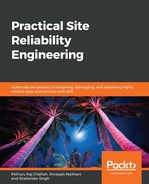It is very true that competent software solutions can drive business innovation, disruption, and ultimately transformation. So, the number of software engineers grows consistently ahead of the number of IT professionals. Hence, IT automation gains prominence. That is, once an application deployment is over, the application has to be continuously monitored, measured, and managed to ensure the application/workload is meeting the expressed needs (functional as well as non-functional requirements).
The performance, scalability, availability, security, and resiliency parameters ought to be minutely monitored, and if there is any deviation or deficiency, then the necessary countermeasures have to be considered in time, with clarity and confidence. Not only the application but also the underlying runtime/execution environment, the associated middleware solutions and databases, and the various IT infrastructure modules have to be continuously monitored to gain a better grip of their state and behavior. The application delivery depends on a collection of software and hardware modules. Every software and hardware module continuously emits a lot of operational, log, performance, security, and other useful data, and it becomes important to carefully capture, cleanse, and crunch them to extricate useful and usable insights in time.
Data science is the new buzzword in the IT marketplace these days. Data collection, pre-processing, ingestion, filtering, massaging, processing, knowledge discovery and dissemination, decision-making, and actuation are the prominent steps in the end-to-end data science life cycle. The operational and log data being generated by all kinds of software and hardware systems are in a way massive and multi-structured. With a series of mesmerizing advancements in the real-time analytics of big and time-series data, the various analytical capabilities of software and hardware systems' data are to help with designing, developing, and deploying smart and sophisticated systems.
That is, there are two things to be taken into consideration. Firstly, the amount of multi-structured data getting generated and captured is growing exponentially. Secondly, there is a realization by business executives and IT professionals that data hides and carries a lot of useful and usable information and insights. Also, the technologies and tools for capturing, storing, and mining poly-structured data are maturing and stabilizing fast. That is, the process of quickly transitioning data into information and into knowledge is being accelerated through the leverage of pioneering platforms, well-laid processes, enabling patterns, and a dazzling array of tools, adapters, drivers, engines, and connectors. Definitely, it is going to be the data-driven insights and the insights-driven world.
In this chapter, we are going to focus on how various types of data are being exposed to a variety of purpose-specific investigations to extract important insights in time and we will also discuss how the emitted insights come in handy in engineering and establishing multifaceted and state-of-the-art software, as well as hardware systems. Specifically, for IT environments, there are some specific data-analysis procedures, processes, and platforms, which will be explained in the following sections.
